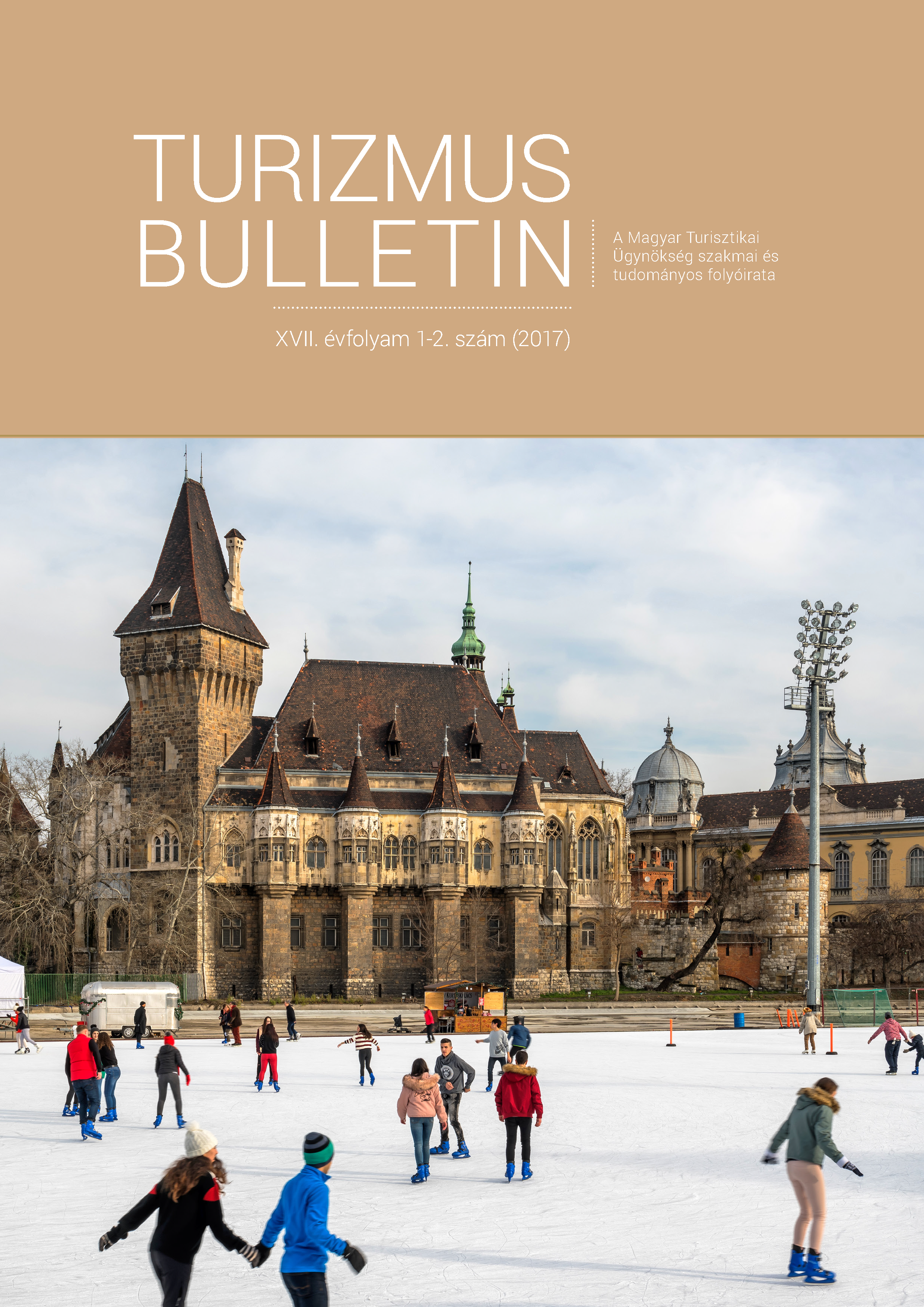A push és a pull motivációk szerepe a magyarok szabadidős utazásai során
DOI:
https://doi.org/10.14267/TURBULL.2017v17n1-2.1Kulcsszavak:
turisztikai marketing, desztinációmenedzsment, turisztikai motivációk, push és pull faktorok, piacszegmentálásAbsztrakt
A nemzetközi turizmuskutatás prosperáló területe az utazási motivációk vizsgálata. Jelen kutatás a magyar lakosság szabadidős utazásainak motivációit vizsgálja kérdőíves felmérés segítségével. A vizsgálat a szakirodalomban széles körben alkalmazott push (ösztönző) és pull (húzó) motivációs elmélet alapján történt. Az elemzés során faktoranalízis segítségével hat push és hat pull motivációt azonosítottunk. A válaszadók egyes demográfiai jellemzői alapján (nem, kor, legmagasabb végzettség, egy főre jutó jövedelem) válaszadói csoportokat képeztünk, majd varianciaanalízis segítségével vizsgáltuk a motivációs különbségeket. A különféle válaszadói csoportok motivációs eltéréseinek komplex vizsgálatával négy szabadidős turisztikai szegmenst azonosítottunk, amelyek létét gyakorlati tapasztalatok, illetve a termék- és szolgáltatásmarketing egyéb példái igazolják.
Hivatkozások
BALOGLU, S. – UYSAL, M. (1996): Market segments of push and pull motivations: A canonical correlation approach. International Journal of Contemporary Hospitality Management. 8(3). pp. 32–38.
BASHAR, A. – AHMED, P. (2010): An Analysis of Push and Pull Travel Motivations of Foreign Tourists to Jordan. International Journal of Business and Management. 5(12). pp. 41-50.
BOWEN, D. – CLARK, J. (2009):Contemporary Tourist Behaviour: Yourself and Others and Tourists. CABI. Cambridge University Press, Cambridge.
CROMPTON, J. L. – McK AY, S. L. (1997): Motives of visitors attending festival events. Annals of Tourism Research. 24(2). pp. 425–439.
CROMPTON, J. L. (1979): Motivations for pleasure vacation. Annals of Tourism Research. 6(4). pp. 408–424.
DANN, G. M. S. (1977): Anomie, ego-enhancement and tourism. Annals of Tourism Research. 4(4). pp. 184–194.
DANN, G. M. S. (1981): Tourist motivation an appraisal. Annals of Tourism Research. 8(2). pp. 1 87–21 9.
DEJTISAK, M. – HURD, A. R. – ELKINS, D. J. – SCHLATTER, B. E. (2009): A Comparison of Travel Decisions Between U.S. and International Students. LARNet. The Cyber Journal of Applied Leisure and Recreation Research: http://larnet.org/2009-02.html
FODNESS, D. (1994): Measuring tourist motivation. Annals of Tourism Research. 21(3). pp. 555–581.
GOOSSENS, C. (2000): Tourism introduction and pleasure motivation. Annals of Tourism Research. 27(2). pp. 301–321.
HUANG, S. (2009): Measuring Tourism motivation: Do Scales matter? MPRA Paper No. 25198: http://mpra.ub.uni-muenchen.de/25198/ISO-A
HOLA, S. E. (1982): Toward a social psychological theory of tourism motivation: A rejoinder. Annals of Tourism Research. 9(2). pp. 256–262.
KIM, S. S. – LEE, C-K. (2002): Push and pull relationships. Annals of Tourism Research. 29(1). pp. 257–260.
MASLOW, A. (1954):Motivation and Personality.Harper, New York.
McGEHEE, N. G. – LOKER-MURPHY, L. – UY-SAL, M. (1996): The Australian international pleasure travel market. Motivations from a gendered Perspective. Journal of Tourism Studies. 7(1). pp. 45-57.
OH, H. C. – UYSAL, M. – WEAVER, P. A. (1995):Product bundles and market segments based on travel motivations: A canonical correlation approach. International Journal of Hospitality Management. 14(2). pp. 123–137.
OOM DO VALLE, P. – SILVA, J. A. – MENDES, J. – GUERREIRO, M. (2006): Tourist Satisfaction and Destination Loyalty intention: A Structural and Categorical Analysis. International Journal of Business Science and Applied Management. 1(1). pp. 25- 44.
PEARCE, P. L. – LEE, U. (2005): Developing the travel career approach to tourist motivation. Journal of Travel Research. 43(3). pp. 226-237.
PEARCE, P. L. (2005):Tourist Behaviour: Themes and Conceptual Schemes. Channel View, Clevedon.
PUCZKÓ L. – RÁTZ T. (2011):Az attrakciótól az élményig. A látogatómenedzsment módszerei. Akadémiai Kiadó, Budapest.
PYO, S. – MIHALIK, B. J. – UYSAL, M. (1989):Attraction attributes and motivations: A canonical correlation analysis. Annals of Tourism Research. 16(2). pp. 277–282.
TOLMAN, E. C. (1959): Principles of purposive behavior. In: Koch, S. (ed): Psychology: A Study of a Science. 2. McGraw-Hill, New York. pp. 92–157.
UYSAL, M – LI, X. – SIRAKAYA-TURK, E. (2008):Push-pull dynamics in travel decision. In: Oh, H. – Pizam, A. (eds), Handbook of Hospitality Marketing Management. pp. 412-439.
UYSAL, M. – HAGAN, L. A. (1993): Motivations of pleasure travel and tourism. In: Khan, M. – Olsen, M. – Var, T. (eds): Encyclopedia of Hospitality and Tourism. pp. 798-810.
UYSAL, M. – JUROWSKI, C. (1994): Testing the push and pull factors. Annals of Tourism Research. 21(4). pp. 844–846.
WILKIE, W. L. (1994):Consumer behavior. Wiley, New York.
YOON, Y. – UYSAL, M. (2005): An examination of the effects of motivation and satisfaction on destination loyalty: a structural model. Tourism Management. 26(1). pp. 45-56.
YOU, X. – OULEARY J. – MORRISON, A. – HONG, G-S. (2000): A crosscultural comparison of travel push and pull factors: United Kingdom vs. Japan. International Journal of Hospitality and Tourism Administration. 1(2). pp. 1–26.

